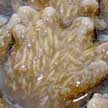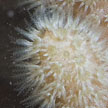|
|
|
|
|
|
| Colony
circular 30-50cm or larger, without ridges or finger-like structures.
The edges may be highly ruffled underwater. Common tissue may be pink,
yellow, orange, greenish or brown. Has siphonozooids Also has autozooids
with long slender body columns (1-2cm), 8 white branched tentacles.
Coral rubble. Commonly seen on our Southern shores. |
Colony
circular 30-50cm or larger, with radiating ridges or lobed flaps.
Common tissue may be pink, orange, greenish, maroon or brown. Has
siphonozooids. Also has autozooids with short bodies (about 1cm) with
8 white branched tentacles. Coral rubble. Commonly seen on our Southern
shores. |
Colony
(10-15cm) thick, disk-like with highly ruffled ridges with fingers
or bumps. Common tissue with large spindle-shaped structures, colour
pinkish, beige, yellowish. Only one kind of polyp (autozooid), tiny
(0.2cm), transparent, 8 short cylindrical tentacles with tiny branches,
the body column hardly seen. Polyps clustered on the edges of the
disk, with fewer in the middle of the disk. In reefs. Sometimes seen
on some of our shores. |
|
|
| |
|
|
|
This
is NOT a leathery soft coral
|
|
|
|
|
|
|
| Colony
10-15cm or larger with round or finger-like structures. Common tissue
bright white. No siphonozooids. Autozooids tiny (0.5cm) with short
body column and 8 brown branched tentacles. Colony is white when the
polyps are completely retracted and brown when the polyps are expanded.
Coral rubble. Commonly seen on our Southern shores. |
Colony
20-50cm or larger with sturdy branches tipped with rounded or finger-like
structures. Common tissue is pale pink or orange sometimes lilac.
No siphonozooids. Autozooids are tiny (0.5cm or smaller) with a short
body column and 8 branched tentacles. Coral rubble. Sometimes seen
on our Southern shores. |
Colony
circular 20-40cm or larger, usually with long finger-like structures.
Common tissue usually pinkish sometimes with tinges of purple. Has
siphonozooids that form 'pimples' on the surface. Also autozooids
with short fat body columns (about 1cm) with 8 white branched tentacles.
Coral rubble. Sometimes seen on our Southern shores. |
|
50cm-1m.
Colony bushy, long stems not frequently branched. Cylindrical, thick
(1cm) fleshy and leathery, with a wire-like central support sometimes
exposed at the tips. Dusky pinkish beige. On coral reefs. Often seen
on our Southern shores. |
















